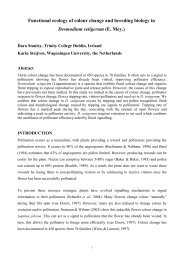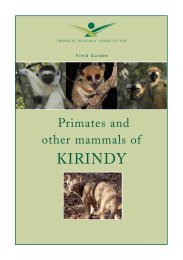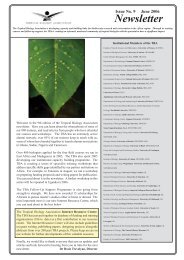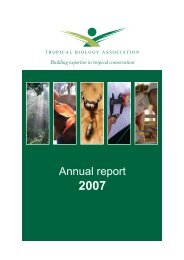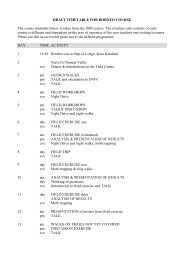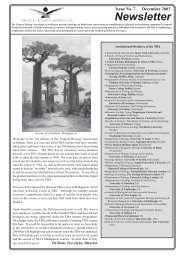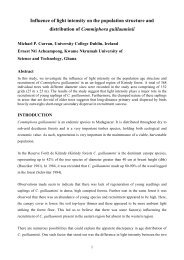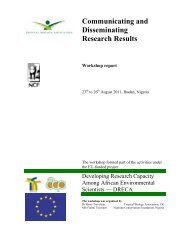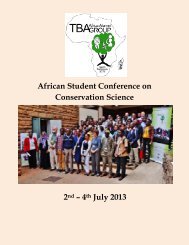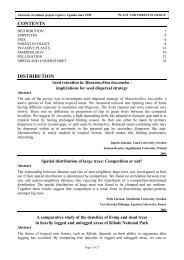Download TAAG Book of Abstracts - Tropical Biology Association
Download TAAG Book of Abstracts - Tropical Biology Association
Download TAAG Book of Abstracts - Tropical Biology Association
Create successful ePaper yourself
Turn your PDF publications into a flip-book with our unique Google optimized e-Paper software.
Diversity, Abundance and Feeding Ecology <strong>of</strong><br />
Mangrove Crabs in Cameroon<br />
Simon. N. Longonje<br />
University <strong>of</strong> Buea, Cameroon<br />
Email for correspondence: nlongonje@yahoo.com<br />
Abstract<br />
The diversity and abundance <strong>of</strong> crab species was studied<br />
in the Cameroon estuary mangrove. Five zones located<br />
from landward to seaward fringes were sampled twice a<br />
month for 6 months, using standard excavation and crab<br />
catching methods. In each zone 10x10m plots were<br />
sampled and 1m 2 quadrat excavated. In total, 1,349<br />
crabs in 13 species were recorded. Five species were<br />
Sesarmidae (38.5%), four species were Grapsidae<br />
(30.8%), two species were Ocypodidae (15.4%), one<br />
species was Portunidae (7.7 %), and one species was<br />
Gecarcinidae (7.7 %). Uca tangeri (Ocypodidae) and<br />
Goniopsis pelii (Grapsidae) were the dominant species,<br />
constituting 44.1% and 21.9 % respectively. The<br />
dominating species in mudflat, young forest and<br />
landward fringe were Uca tangeri, Goniopsis pelii and<br />
Cardisoma respectively. The feeding ecology <strong>of</strong> several<br />
species <strong>of</strong> mangrove crabs was studied through<br />
tethering experiments and gut analyses. Feeding<br />
preference was determined on fresh and senescent<br />
leaves <strong>of</strong> Laguncularia racemosa, Avicennia germinans<br />
and Rhizophora species while propagule predation was<br />
investigated on Rhizophora mangle, R. harrisonii and R.<br />
racemosa. Gut content analysis was done on<br />
Metagrapsus curvatus, Sesarma huzardi, S. elegans, S.<br />
alberti, G. pelii and Grapsusgrapsusto assess their<br />
natural diets. The field observations suggest that 65.9%<br />
<strong>of</strong> the propagules studied were predated and 71.3% <strong>of</strong><br />
the leaves damaged. Mangrove material was the main<br />
component <strong>of</strong> crab’s diet: M. curvatus (45.4%) S.<br />
elegans (55.0%), S. Alberti (62.5%), G. pelii (65.9%) S.<br />
huzardi (47.8%) and G. grapsus (37.3%). Damage on<br />
young mangrove trees was highly correlated to the<br />
number <strong>of</strong> crabs on trees (r 2 = 0.75). The high damage<br />
rate <strong>of</strong> mangrove materials indicate that crabs play a<br />
significant ecological role in the functioning <strong>of</strong> the<br />
mangrove ecosystem, by affecting mangrove<br />
recruitment and biogeochemical functioning.<br />
Assessment <strong>of</strong> Fauna Resources <strong>of</strong> Oli River Complex at<br />
Kainji Lake National Park, Nigeria<br />
Folusade Catherine Arowosafe<br />
Federal University <strong>of</strong> Technology, Akure, Nigeria<br />
Email for correspondence:folukate@gmail.com<br />
Abstract<br />
The Oli River <strong>of</strong> the Kainji Lake National Park provides<br />
water for the wild animals throughout the year making<br />
it a hotspot for ecotourism because <strong>of</strong> its unique<br />
assemblages <strong>of</strong> flora and fauna more visible during the<br />
dry season when the animals come for water at the<br />
river. This research, focused on the natural resources <strong>of</strong><br />
Oli River complex. The resources in and around Oli River<br />
were assessed. Oral interviews and Park records were<br />
used in the process <strong>of</strong> data collection. The animal<br />
diversity was assessed using direct and indirect<br />
methods: the direct method used involved road count<br />
method while indirect methods include faecal<br />
droppings, footprints and calls. Random collection <strong>of</strong><br />
fish from different points in the river was used in<br />
assessing the fish diversity. A total <strong>of</strong> 22 fish species in<br />
11 families were identified. Animals identified around<br />
the river include the Hippopotamus (24.2%), Kob<br />
(16.7%), Roan antelope (16.7%), Duiker (10.6%), Reed<br />
buck (4.6%), Warthog (15%), and Bird species (12.2%).<br />
Findings revealed that there is concentration <strong>of</strong> effort to<br />
reduce human activities such as poaching that could<br />
affect the conservation <strong>of</strong> the animals found in the park.<br />
As such management policies which allows game<br />
viewing for tourist but do not permit sport fishing and<br />
game hunting has gone a long way to meet the objective<br />
<strong>of</strong> conserving the animals found in and around the Oli<br />
River.<br />
Keywords: Natural resources, Oli River, Ecotourism,<br />
Conservation, Diversity<br />
Keywords: Mangrove crabs, Community structure,<br />
Feeding Behaviour, Biodiversity conservation, Cameroon<br />
<strong>TAAG</strong> First African Student’s Conference, Nairobi. 2-4 July, 2013 21




